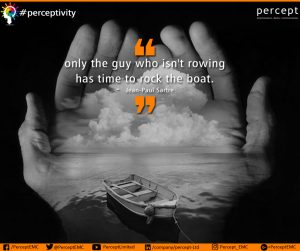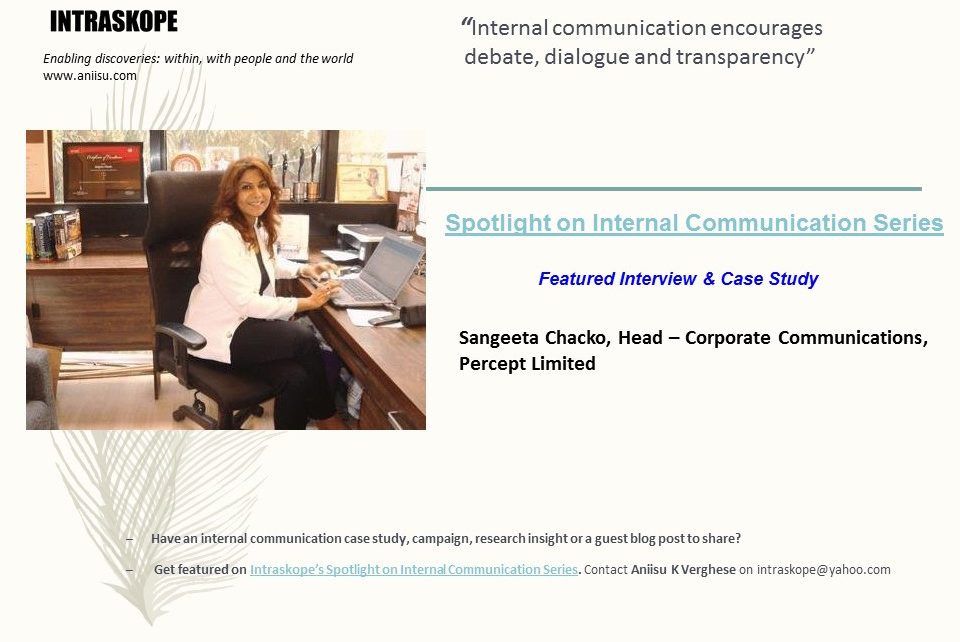You can also now subscribe to my YouTube Channel for more updates.
Does internal communications have to be serious and formal? Can internal communicators raise the bar by infusing interactivity and creativity in their work?
Sangeeta Chacko, Head – Corporate Communications, Percept Limited definitely believes it is possible to be cool and yet connect employees effectively. Being mindful of the different generations at the workplace, getting a pulse of how they think and creating relevant messages that matter are some of the tips she shares in the 10th edition of Intraskope’s Spotlight on Internal Communication Series.
Do read her interview and case study here and share your thoughts.
Sangeeta has 24 years of proficient experience in the Marketing & Communications with leading global organizations including O&M Advertising, The Walt Disney Group, TCI, Abacus and Kuoni. An international & national award winner, she is a recipient of the 2017 Albert Nelson Marquis Lifetime Achievement Award and has been featured in the ‘Marquis Who’s Who In The World®’ 2014, 2015 & 2016 Directories featuring global achievers. She has also been conferred with the ‘World Women Super Achiever Leadership Award’ in 2017, the ‘Bharat Excellence Award’ and ‘Rashtriya Mahila Gold Award’ in 2014, the ‘Outstanding International Business Communicator Award’ and the ‘Rashtriya Nirman Ratna Award’ in 2013 in recognition of her outstanding contribution to the communications, academics and the CSR domains.
- What does internal communications mean to you?
Internal communications encodes the heart of the company. A well-communicated vision provides employees with a memorable and a strong company goal. A key component in establishing and driving that vision lies in leveraging a dynamic, thoughtful and holistic internal communications strategy that allows for a conjunct comprehension of the management’s vision and what actions employees need to take to achieve this vision.
Internal communications has a dynamic and multifarious role in business today viz.
- Communicating the organization’s mission, vision, brand image, personality, positioning and branding strategy to internal stakeholders
- Increasing awareness of the organization’s suite of diversified businesses, products & service offerings, new launches, and news updates
- Creating robust brand ambassadors from within
- Creating an effective knowledge share platform for employees
- Driving brand ownership & accountability within the organization
- Engaging, bonding and fostering a sense of community at all levels in the organization through seamless communication and interactions
- How is it practiced in your organization?
At Percept we introduced a range of online and offline activities to drive internal communications. These include:
- P2P – the monthly e-Newsletter. This e-magazine communicates with employees across group companies by sharing the latest news, activity updates and developments, enhancing employee pride, brand ownership and belongingness. This newsletter also drives interaction by showcasing employees’ talent and voices and running a series of creative contests.
- Chairman’s weekly messages: An e-note addressed every Monday morning to all employees makes a world of difference and tremendously motivates the team. It also enables better connection between senior leaders and employees across the organization.
- Spotlight: A fortnightly newscast that captures key account wins, achievements, awards, accolades, announcements and other key developments across the Percept Group
- Perceptivity of the Day: A daily motivational quote with a memorable fun image that helps kick-start the employees day on a high note
- Corporate Intranet: The in-house multi-purpose website that offers relevant information access, enables critical data access, increases interactivity, and more
- Corporate Communications Manual: The guidelines for employees on internal and external stakeholder communications and activities.
- Corporate Branded Merchandise: Designing innovative and unique branded merchandise that serve as giveaways, memorabilia & prizes to internal stakeholders
- Company Anniversary Celebrations: A forum for celebrations, informal brunches and get-togethers within the premise to increase engagement and motivation across Group company staff
- Percept Annual Conference & Awards Night: A common platform for all key and senior employees to meet, exchange ideas and best practices, share future business plans and align with the Percept vision. The Gala Awards night recognizes and rewards employees who have outperformed across identified parameters in the previous fiscal year, and serves as a great platform for Perceptites to unwind, let their hair down and party in a fun and informal environment.
- Please share an example / campaign that you are personally proud of working on and that made a significant impact to your organization?
Given the fact that we are a dynamic organization that spans 3 – 4 generations of employees at the workplace and work in a fast paced industry, employee fatigue, burn-out and high rates of attrition occur. In order to inspire our staff we created a simple yet fun internal e-mailer aptly entitled ‘Perceptivity’ that shared an inspirational quote (with a twist) and an even more visually intriguing image that enabled much conversation and connect amongst employees. Conceptualized and designed internally by the Corporate Communication Team, ‘Perceptivity’ is sent every morning at 9.30 am and reaches every Perceptite across 43 locations in 8 cities pan India and overseas.

The annual Corporate Communication internal stakeholder audit 2017 revealed that these mailers were much appreciated as a great way to kick-start the day, encouraged debate, dialogue and openness, created belongingness in an inclusive and constructive manner. Employee feedback has further helped our team raise the bar of creativity and quirkiness of these mailers in the past quarter.
- What is the biggest challenge you face while going about managing Internal Communications?
Garnering content from our own employees is my greatest challenge. Given the stringent deadlines we face to rollout our monthly newsletters and other daily announcements, it gets tough when inordinate delays occur in receiving articles, inputs, supporting images and data from employees, It is tougher to meet than the strict deadline that we have committed ourselves to.
- What according to you is the biggest opportunity that internal communicators have?
In the past, internal communications served as a platform for voicing the views of senior management, and was rarely about communicating the reality or being honest with staff. The new crop of emerging internal communications specialists are bolder and better aware of their roles as practitioners. They are far more sceptical and demanding. Millennials are digital natives in the workforce, and have higher expectations when it comes to a transparent, open, authentic communication. Innovation, looking at big picture and using the power of the internet to create a transparent internal communications plan has now gained momentum with the younger breed, and for good reason too. There are studies that indicate a majority of employees think that effective internal communications helps their job performance and a similar segment want their employer to keep them informed so they can impart relevant company news with others.
However, in life and in business, good internal communication starts with listening. Instead of taking the traditional “push” method of sending out communication, internal communications specialists need to use data and solicit feedback to pull in ideas for how their workforce wants to receive information, and create a plan accordingly.
Employees can’t share what they don’t know. In summary, when a company honestly and effectively communicates internally with their employees, they in turn, are empowered to become brand champions and communicate on behalf of the business. This results in good word-of-mouth publicity, admiration and recall for the company and its products and services.
- How can internal communicators add more value to the business?
When internal communications is strategically planned, implemented and monitored systematically, one can immediately see greater levels of engagement, motivation and brand pride amongst the workforce. This also translates into lower attrition rates even as the company attempts to attract and retain the best talent from the industry. Above all, contented employees take initiative to become brand ambassadors and propel the brand forward.
- What is your advice for people keen to join internal communications and make it a career? What skills must they have or develop?
Excellent communications skills, both verbal and written, are paramount. Diplomacy, tact, an ability to navigate the workforce environment, and to do so strategically, is vital. The person must have the capability at building very strong relationships both with senior management and employees, influence leaders, pre-empt risks, negotiate conflicts, coordinate resources and inspire action. Confidence, and an ability to deliver to timelines are important. While digital skills are important today, the best internal communicators use a mix of different channels, new and traditional, online and offline, to ensure genuine two-way communication, information sharing and data collation. And above all, courage is important. The courage to stand up and say what you think, about being informed and having an opinion, and not being fearful of challenging the status quo constructively.
Case Study
Issue that needed addressing
We wanted to improve employee morale, motivation, engagement and fun at Percept.
- What was the intervention?
Our internal pulse checks indicated that employees were low on morale, especially during off or peak seasons at work. As a media and entertainment organization this was a concern we needed to tackle.
- Your/team’s role in crafting a solution
We reached out to understand the issue and realized that employees were looking for a platform to engage, learn and have conversations that stimulate dialogue. We therefore designed an interactive and online daily mailer in March 2016 that reaches 650 Perceptites across 43 locations in 8 cities in India and overseas. The goal was to bring in positive change in the way of working for our staff.
- The impact it had
The response was overwhelming with 80% of employees polled giving it is a 4 of out of 5 rating.
- How it changed the way stakeholders perceived your team
It has significantly changed how corporate communication is viewed. It doesn’t need to be serious. It needs to understand what employees need.
- Your personal learning which other practitioners can benefit from
In today’s world, internal communications need to constantly innovate and engage employees in a fun and cost effective manner. It needs to show the human side of management and yet be clear and differentiating. There has to be however a balance – to be sensitive to the needs and preferences of employees.
- What would you have done differently if you were to revisit the approach?
This seemed to work well. However, there are opportunities to improve the value of this communication through designs, increasing the quirkiness, challenging and stimulating the minds of our readers even more.
Liked this interview and case study? Please share your views here.
Missed previous stories from organizations featured on the Intraskope’s Spotlight on Internal Communication Series? Look them up here – Infosys, SOBHA Ltd., ICICI Securities, First Advantage, CK Birla Group, TVS Motors, GE, Suzlon and Tata Sons.
If you are an internal communication practitioner working in a firm or a not-for-profit and have an internal communication case study, campaign, research insight or a guest blog post to share please contact me on [email protected]
